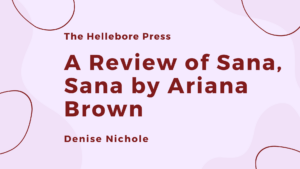Overview
Moth Funerals contends with the impossibility of womanhood through bold and piercing vignettes that defy and heal. Throughout each poem, Gaia Rajan, redefines language, challenging the burdens and restrictions that society places on women of color. Rajan examines age, identity, relationships, and society at large to reclaim truth. Death is but a rebirth, a stage in which the body must perish for the soul to become restored.
The Magnetic Poetic Presence of Gaia Rajan
Gaia Rajan’s talent is undeniable as she creates poems that move through one another, building off of the reader’s emotions and greatest anticipations, relating to the parts of us that are denied agency, choice, and fullness. Rajan holds readers to the fire, with a warmth, sharpness, and urgency that commands us to confront the ways in which society has failed young women. But Rajan is not only reshaping the conversation, she is also innovating the poetic form as we know it, which is evident in the poems, “Juliet I”, and “Juliet II”.
Shattering Expectations through Lyrical Innovations
Society expects goodness, purity, and innocence from Black and Brown girls. Godliness, goodness, proximity to whiteness, or desirability from men become the conditions of our value.
Society mines women of color for their cultural contributions; interrogates women of color for their authenticity and merit; demands women of color to quantify their worth; and punishes women of color when they dare to be more.
Young woman of color defy all expectations but must reconcile with their hope to be validated:
Every time I realize
I’ve gotten older it feels like I’m escaping
something, escaping all the ghostsI could’ve become. If I say the moth
could’ve been alive does that make me
a monster or a necromancer. Naïveor a ghost. If I answer your names with I don’t
from, [self-portrait as moth]
know am I a liar or hopeful. I am all
the usual questions. I am trying so hard to be good.
Upending the White Gaze & Consumption of Women of Color
While these interrogations may take place in the public sphere, they do not always include the presence of women. Although the conflict between goodness and desirability cannot be reduced to soundbites in locker rooms, it is amplified by the boys and men who objectify girls and women:
The world is a cavern of mouths, and
from, Poem Inside a Locker Room
you, you are bone-chewed, porous, more gape than girl. When
it begins the other boys hide. Your hide. Girl, you’re
a woman now, behind the lockers’ teeth. Womanhood a
flood of molars, dissolving, dissolved. Won’t you light a star
for the men?
Society consumes women of color. Men are protected, defended, and upheld.
Moth Funerals, personifies creatures (birds, moths, ghosts) as extensions of girlhood to critique society’s theft of youth and culture and to differentiate the realities for women of color in comparison to men:
I could be anything: thief, vulture, woman
invisible, ghost, gone. And in a way, you’re right:the country you live in is not the same as mine.
from, To the Man Who Yelled “Go Back to Your Own Country”
Women of color must camouflage themselves into their surroundings to survive, mutating into the versions of themselves that are acceptable. But as they adapt and change, they risk losing who they are. It does not matter how close they come to God. It does not matter how much they outperform or outshine. Women of color still live in the shadows.
Radical Revelations
There is no right way for young women to be young women. Especially for young women of color who cannot exist freely in a world where the default is whiteness. Women of color are stereotyped as threats and disrupters, yet are met with violence and harassment. Who is the real threat? Furthermore, how can we uplift and empower youth to pursue their dreams, when we do not even grant them the liberty to pursue their truth? When we penalize them for combatting the systems that seek to exploit them?
Society demands perfection, conformity, and sacrifice from young women. Youth must compromise who they are to reach who they must become. In order to break away from these standards, the speaker of Moth Funerals, fiercely proclaims
I am a godless girl, by which I mean
from, [self portrait as pupa]
my body has always been mine.
The speaker is liberated from religious and societal restrictions.
Conclusion
Moth Funerals draws upon dark truths to uncover renewal, a reawakening of the self– which can only be restored through rebellion, defiance, and radical self love. Throughout each poem, readers become witness to the sheer power that Gaia Rajan embodies.
Gaia Rajan is the leading voice of her generation. Read her book, Moth Funerals. Read everything she writes so you too can discover resistance and transformation.
From the Author’s Website:
Gaia Rajan is the cofounder of the WOC Speak Reading Series, the Junior Journal Editor for Half Mystic, the Web Manager for Honey Literary, the Managing Editor of The Courant, and the Poetry Editor of Saffron Literary.
Her work has previously appeared or is forthcoming in the Kenyon Review, Tinderbox Poetry, Up the Staircase Quarterly, Palette Poetry, Muzzle Magazine, DIALOGIST, Split Lip Magazine, diode, and elsewhere. Her poems have been nominated for Best of the Net.
She is the first place winner of the Princeton Leonard P. Milberg Poetry Prize, Sarah Mook Poetry Prize, and 1455 Literary Festival Contest, and runner up for the Smith College Poetry Prize, Nancy Thorp Poetry Prize, and Patricia Grodd Poetry Prize. She is also the recipient of national awards from the YoungArts Foundation and the Scholastic Art and Writing Awards.
Her chapbook, ‘Moth Funerals,’ is out now from Glass Poetry Press, and she is a National Student Poet semifinalist. When not writing, she’s listening to Phoebe Bridgers, programming new apps, or chancing down Wikipedia rabbit holes.
To purchase Moth Funerals visit: Glass Poetry Press.


